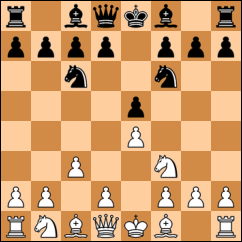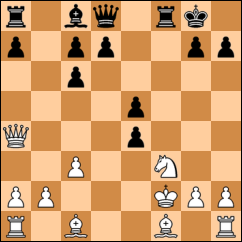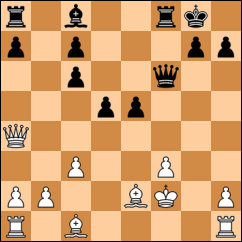Ponziani Frasher Defense
Cicindelinae (1835) — AnotherFineMess (1717)
ICS rated standard match (-) chessclub.com
2012.12.09 1-0 C44p
1.e4 e5 2.Nf3 Nc6 3.c3

- This is the Ponziani opening and goes all the way back to the 1500’s. It’s an opening I’ve been toying with for a while. The Ruy Lopez may be the Cadillac of the 1.e4 openings, but there are a lot of variations to learn. The Ponziani is a little simpler and there aren’t too many variations where White can get into trouble right off the bat. To add to it, Black is often unfamiliar with “the Ponz”.
3…Nf6

- The most popular variation though there are some other moves White must be prepared to meet.
- ( 3…d5 Since White is a little slow to take charge in the center, Black decides he’s going to. 4.Qa4 ( 4.Bb5 Is another option, though generally considered not as good as 4.Qa4 for White if Black knows how to react. 4…f6 5.Qa4 Ne7 6.exd5 Qxd5 7.O-O Be6 8.d4 e4 9.Nfd2 O-O-O 10.Bc4 Qf5 11.Re1 Bd5 12.Bxd5 Nxd5 13.Nxe4 Nb6 14.Qd1 h5 15.Nbd2 h4 16.h3 Kb8 17.Qf3 Qg6 18.Nb3 Nd7 19.Bf4 Rh5 20.Ned2 Re8 21.Nc4 Rb5 22.Qd3 Qf7 23.d5 Rxe1+ 24.Rxe1 Nd8 25.d6 c6 26.Re7 Rd5 27.Rxf7 Rxd3 28.Rxd7 Rd1+ 29.Kh2 Ne6 30.Nc5 Kc8 31.Nxe6 Kxd7 32.Nxf8+ Ke8 33.d7+ Kxf8 34.Bd6+ Rxd6 35.Nxd6 Ke7 36.Nxb7 Kxd7 37.Kg1 Ke6 38.Kf1 1-0 Brankovic, De (2352) – Petrovic, Mari (2208) / 3rd Open (2), Paracin SRB 2010 ) 4…Bd7 5.exd5 Nd4 6.Qd1 Nxf3+ 7.Qxf3 Nf6 8.Bc4 Bd6 9.d4 exd4 10.O-O Ng4 11.Re1+ Kf8 12.Bf4 Qf6 13.Bxd6+ Qxd6 14.Qg3 Qxg3 15.hxg3 h5 16.cxd4 Rh6 17.Nd2 Rb6 18.Nb3 Be8 19.Rac1 Nf6 20.Re5 a5 21.Rc2 a4 22.Nd2 g6 23.Be2 Rd8 24.Nc4 Ra6 25.Bf3 Bd7 26.Rc3 Ne8 27.Re1 Bc8 28.Rec1 Ra7 29.a3 Bd7 30.Ne3 Ke7 31.Be2 Rc8 32.f4 b6 33.f5 Bxf5 34.Nxf5+ gxf5 35.Bxh5 Nd6 36.g4 f4 37.g5 Nb5 38.Re1+ Kf8 39.Rf3 Re8 40.Ref1 Nd6 41.Rxf4 Kg7 42.Bxf7 Re2 43.Bh5 Rxb2 44.Re1 c6 45.dxc6 Rb3 46.Rf6 Nb5 47.Re8 Rxa3 48.Rg6+ Kf7 49.Rh6+ 1-0 Lubashov, A (2414) – Odinokov, N (2349) / TCh-RUS (2), Togliatti RUS 2003 )
- ( 3…f5 Is an aggressive option in the spirit of the Latvian. This is an exciting game from the 2007 US Championships where Nakamura ends up losing. 4.d4 fxe4 5.Nxe5 Nf6 6.Bb5 Bd6 7.Nc4 Be7 8.Ba4 d5 9.Ne5 O-O 10.Bxc6 bxc6 11.Nxc6 Qe8 12.Nxe7+ Qxe7 13.O-O Ng4 14.h3 e3 15.Bxe3 Nxe3 16.fxe3 Bxh3 17.Rf3 Bg4 18.Rxf8+ Rxf8 19.Qe1 Rf6 20.Nd2 Rg6 21.Qg3 Qe6 22.Qf4 Bh3 23.g3 h5 24.e4 Rg4 25.Qxc7 h4 26.Kh2 hxg3+ 27.Kxh3 Rxe4+ 28.Kg2 Re2+ 29.Kxg3 Qe3+ 30.Kh4 Qh6+ 31.Kg3 Qg5+ 32.Kh3 Rxd2 33.Qc8+ Kh7 0-1 Nakamura, H (2658) – Becerra Rivero, J (2544) / ch-USA (9), Stillwater USA 2007 )
4.d4 Nxe4

- ( 4…exd4 5.e5 Nd5 6.Bc4 Nb6 7.Bb3 dxc3 8.Nxc3 h6 9. O-O Be7 10. Bf4 O-O 11. Qd3 d6 12. Bc2 g6 13. Bxh6 Re8 14. exd6 Bxd6 15. a3 Bg4 16. h3 Bxf3 17. Qxf3 Ne5 18. Qxb7 g5 19. Qe4 Ng6 20. Qf3 Ne5 21. Qf5 Ng6 22. Bb3 Qe7 23. Qxg6+ {1-0 Cicindelinae (1508) – Melbourne (1403) / ICS rated blitz match (-), chessclub.com 2012})
5.d5 Bc5

- The very risky and suspect Fraser Defense. I haven’t met it before, but it was only a matter of time. At this point I was trying to remember how to combat this, if White gets it wrong then Black could win in swashbuckling style.
- ( 5…Ne7 6.Nxe5 Ng6 7.Qe2 Nxe5 8.Qxe4 Qe7 9.Be3 d6 10.Nd2 g6 11.Bb5+ Bd7 12.Bxd7+ Nxd7 13.Qd4 Qe5 14.Qc4 Rc8 15.O-O Qh5 16.Bd4 Rg8 17.Ne4 Be7 18.Rfe1 Kf8 19.Ng3 Qh6 20.Qb5 Nb6 21.a4 Qg5 22.Be3 Qh4 23.a5 a6 24.Qb3 Qc4 25.Qxc4 Nxc4 26.Bh6+ Ke8 27.Bg5 1-0 Cicindelinae (1823) – pokemonmate (1887) / ICS rated standard match (-), chessclub.com 2012 )
6.dxc6 Bxf2+

- ( 6…Nxf2 Seems like it would be crushing for White, but in reality Black ends up worse. In going for the material win Black is actually exchanging his two active pieces for a rook White hasn’t even moved yet. White will also get open lines and some initiative. All in all, favorable to White. 7.Qd5 Nxh1 ( 7…dxc6 8.Qxc5 Qd1+ 9.Kxf2 Qxc1 10.Qxe5+ Be6 11.Bc4 Qxh1 12.Bxe6 fxe6 13.Qxe6+ Kd8 14.Ne5 Rf8+ 15.Nf7+ Rxf7+ 16.Qxf7 Rc8 17.Qf8+ Kd7 18.Qxg7+ Kd8 19.Qg8+ Kd7 20.Qxh7+ Kd8 21.a4 Qc1 22.Qd3+ Ke8 23.Qd2 Qxd2+ 24.Nxd2 1-0 cbu (2137) – Kamikazepawn (1905) / FICS rated standard game (?), FICS 2009 ) 8.Qxc5 e4 9.Qe5+ Qe7 10.Qxe7+ Kxe7 11.Ng5 d5 12.cxb7 Bxb7 13.Be3 h6 14.Nh3 Bc8 15.g3 Rd8 16.Nd2 Rb8 17.O-O-O Bg4 18.Re1 Rd6 19.Bg2 Bxh3 20.Bxh3 Ra6 21.a3 Nxg3 22.hxg3 Re8 23.Nb3 Rg6 24.Bf4 1-0 Pinball (2131) – matteogianluca (1944) / FICS rated standard game (?), FICS 2003 )
7.Ke2 bxc6 8.Qa4 f5

- ( 8…d5 The point of Qa4 is revealed. 9.Qxc6+ Qd7 10.Qxd7+ ( 10.Qxa8 O-O Is very dangerous for White, he cannot get too greedy. ) 10…Bxd7 11.Nbd2 Bc5 12.Nxe4 dxe4 13.Nxe5 And a pawn is not nearly enough compensation for the piece. )
9.Nbd2 O-O

- ( 9…Nxd2 10.Bxd2 White doesn’t have to take the Bishop right away as it has a hard time finding a good spot. Plus there are other threats that Black must face, for instance the e-pawn is loose. )
10.Nxe4 fxe4 11.Kxf2

- ( 11.Qxe4 Is another way to go, but I prefered to take out Black’s only real active piece. Even if it puts my king in a pin, I felt I could get out of it with a plus. 11…Bb6 12.Kd1 d5 13.Qxe5 Bf5 14.Be3 Qd7 15.Bxb6 cxb6 16.Kd2 Rae8 17.Qg3 c5 18.Re1 Qa4 19.Bd3 Bxd3 20.Kxd3 Re4 21.Qd6 Qxa2 22.Nd2 Rxe1 23.Rxe1 Qxb2 24.Qxd5+ Kh8 25.Re7 c4+ 26.Ke2 Qxc3 27.Qxc4 Qf6 28.Rxa7 Qf2+ 29.Kd1 b5 30.Qc7 Qxg2 31.Rb7 Qg4+ 32.Kc1 h6 33.Rxb5 Qg1+ 34.Kb2 Qd4+ 35.Qc3 Qf2 36.Rb7 Qg2 37.Qb4 Rd8 38.Rb8 Rxb8 39.Qxb8+ Kh7 40.Qf4 Qb7+ 41.Kc3 Qc8+ 42.Kd4 Qd8+ 43.Ke3 Qb6+ 44.Kf3 Qg1 45.Ke2 g5 46.Qf7+ Kh8 47.Qf2 Qa1 48.Kf3 Qa8+ 49.Kg4 Qd8 50.Ne4 h5+ 51.Kxh5 Qe8+ 52.Kh6 1-0 Csapo, Z (2163) – Kayar, E (2191) / FSIMA May (8), Budapest HUN 2006 )
11…exf3

- ( 11…d5 Black can put up more of a fight by getting the pawn center rolling. This also frees the Bishop to get into the action on the kingside. 12.h4 Qd6 13.Be2 exf3 14.gxf3 e4 ( 14…c5 And the computer gives White only a slight edge. I think it should be easier for Black to organize his forces. ) 15.f4 c5 16.Be3 Bd7 17.Qd1 Rab8 18.b3 Bc6 19.Qd2 Rbd8 20.Rhd1 ( 20.Rad1 The rook on h1 is needed to guard the flank. ) 20…Rf6 ( 20…Qf6 21.Kg3 d4 22.cxd4 cxd4 23.Bxd4 Qg6+ 24.Kf2 Qh6 And it seems a draw by repitition is likely since otherwise Black’s forces put the White king under serious fire. ) 21.b4 cxb4 22.cxb4 Rh6 23.h5 Qe7 24.Kg3 Ba4 25.Rh1 d4 26.Bxd4 Qd7 27.Bc4+ Kh8 28.Bxg7+ Qxg7+ 29.Kh4 Rxd2 30.Rhg1 Qf6+ 0-1 Grobelsek, A (2079) – Sargac, R (2243) / 12th Women (2), Zadar CRO 2005 )
12.gxf3 Qf6

- ( 12…d5 Black really has to play this move in order to get some counterplay going. 13.Rg1 ( 13.Qxc6 Another example where White shouldn’t get greedy. 13…Bg4 14.Kg3 Bxf3 15.Rg1 Rf6 16.Bg5 Rxc6 17.Bxd8 Rg6+ 18.Kxf3 Rxg1 With a roughly equal position. ) 13…e4 14.Rg3 Qd6 15.Be2 Bg4 16.f4 Bxe2 17.Kxe2 With advantage for White, but if he’s not careful Black could organize a threatening breakthrough and that passed e pawn needs to be watched. )
13.Be2 d5

- Too late.
14.Rg1 h6 15.Be3 Rb8 16.b3 a6 17.Rg3 Rf7 18.Rag1 e4 19.Bd4

- ( 19.Qd4 The computer suggests this move as even better. 19…Qxd4 20.Bxd4 g5 21.Ke3 exf3 22.Rxf3 Rxf3+ 23.Bxf3 And Black has zero threats while White is aiming at the Black king. )
19…Qh4 20.Bxg7

- ( 20.Qxc6 Again the computer suggests this as better. It’s simple and strong, but I couldn’t resist breaking open the kingside. )
20…Rxg7 21.Ke3 Rxg3 22.Rxg3+ Kf8 23.Qxc6

- And Black doesn’t have an adequate defense to the infiltration of White’s Queen and Rook so AnotherFineMess resigns
1-0